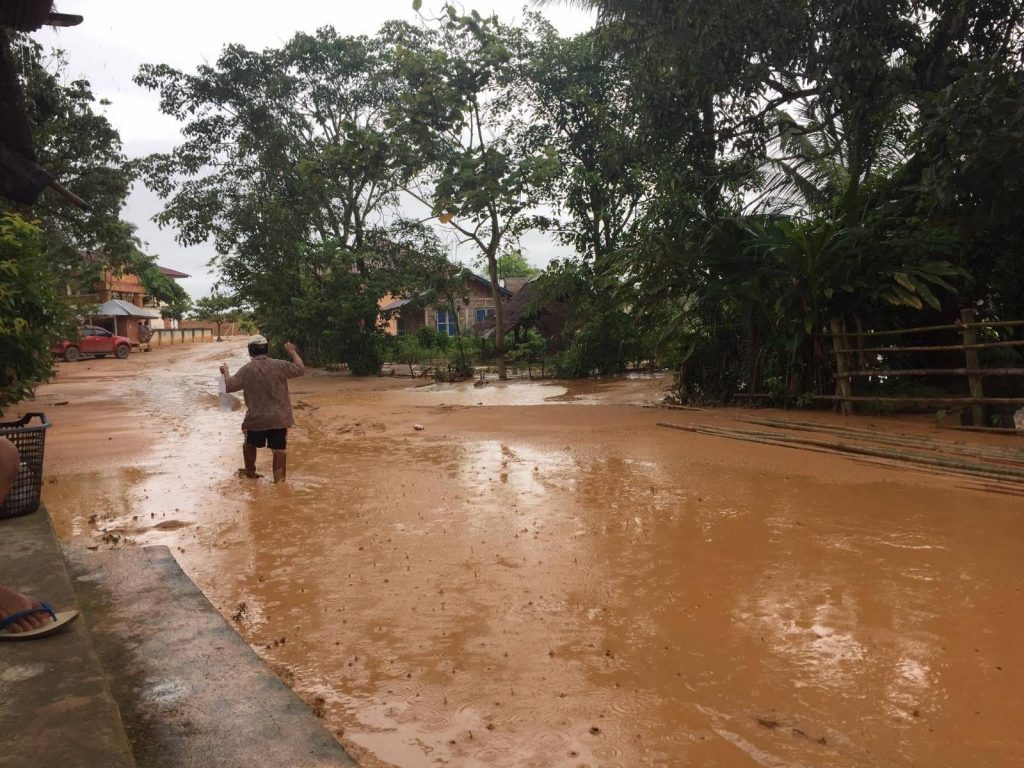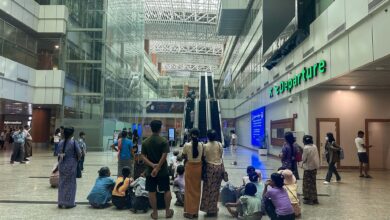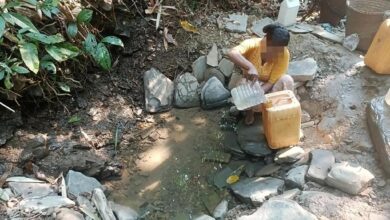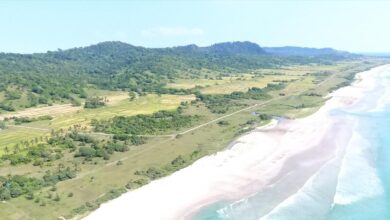
Fifty-year-old ethnic Shan farmer Sai Win said he can no longer sleep during heavy rains, the sound of which brings back terrifying memories of flood waters destroying his home and farmland in his eastern Shan State village of Na Hai Long.
The community is located downstream from mining sites in the Loi Kham hills of Tachileik Township, where there has been a surge in gold mining since Myanmar’s 2021 coup.
Since a dozen gold mining companies started operations in the area in 2007, the local population has increasingly been forced to cope with flooding, toxic sediment and polluted water caused by extractive industry activities in the region.
According to the Shan Human Rights Foundation (SHRF), at least 20 gold mining permits for the area have been granted to companies during this time, several of which are linked to military personnel. The township is home to Shan, Lahu and Akha ethnic minorities.
Forests in the Loi Kham hills were uprooted to make way for large-scale gold mining, causing massive soil erosion and sending mud rushing through the Nam Kham stream and into Sai Win’s village every rainy season.
“Gold miners have discharged mining waste into the Nam Kham stream. When the stream’s water went high, it discharged that waste onto our farmlands,” Sai Win said.
This past monsoon season was one of the worst, as Myanmar, along with other Southeast Asian nations, experienced unusually intense rainfall. In August, a flood swallowed one-third of Sai Win’s house; he had already lost two-thirds of his farmland to previous floods and had been unable to plant any crops due to the thick layer of dry sediment now covering the ground, rendering it infertile.
Since losing his income from farming, he has been struggling to feed his four children, noting that he was also no longer able to fish in the Nam Kham stream because its water had been contaminated by cyanide, which is used in the process of gold extraction.

Nang Mu, a 42-year-old with two daughters, was one of 20 people who lost her home in another area flood in October. Her family has since been forced to live in a makeshift tent in the backyard of a relative.
“Living in someone else’s house is difficult for women, especially for my teenage daughters. Although my children are physically safe, they don’t feel at ease, like they would if they were staying at our own house,” she explained.
They cannot fetch clean water from streams or wells, which have been contaminated by mud. They now buy bottled drinking water and use muddy water for cooking and washing.
“I don’t want to use dirty water to bathe. It makes me itch,” said Nang Mu’s daughter Khu Khu, who has not been able to continue her schooling since the flooding.
Mining surge
Mining activities have increased in Tachileik since the military coup in February 2021, with many fast-tracked permits for new projects given to companies linked to the military. Local human rights and environmental groups have speculated that the military is after quick cash to sustain itself during a spiralling economic downturn.
SHRF reported earlier this year that 13 new mining permits in Tachileik’s Mong Len village tract—where Na Hai Long is located—were allocated to eight companies in mid-2020, with seven more granted to five companies in 2021. Each permit is for a 20-acre plot for a period of up to 11 years.
Many of these companies have ties with former members of the Myanmar army’s Triangle Regional Command (TRC) based in eastern Shan State’s Kengtung.
These include Mayflower Mining Enterprises, set up by Kyaw Win—described by SHRF as an “infamous military crony”—and Lwe Kham Lone Mining, which was directed by the son of former TRC commander Maj-Gen Kyaw Phyo until 2018.
Aung Woon Nay Co Ltd, which was granted two permits, is headed by former TRC general staff officer Lt-Col Zaw Htun Myint, according to SHRF’s report.
Military personnel and their affiliated cronies and militias have for decades aggressively attempted to claim and monetise the country’s natural resources in order to build wealth, despite long-held objections by local populations.
Eastern Shan State villagers pointed out that burgeoning channels introduced by the ousted elected government to file grievances about extractive industry activities were eradicated when the military seized power.
“Now we can’t complain about anything after the coup, or report to anyone. We used to have members of parliament [representing us], so the gold mining companies were monitored and watched,” Sai Min, another resident of Na Hai Long, said.

An SHRF spokesperson added that locals have been threatened with lawsuits and violence for speaking out about the negative impacts of gold mining.
Such actions have in the past had deadly consequences. In 2015, a group of farmers and environmental activists climbed the Loi Kham hills to inspect and gather information about the gold mining sites in the area. They were confronted by Myanmar army soldiers who shot and killed one farmer and injured six others.
Local media outlet Shan Herald Agency for News reported that the troops had claimed that the shooting was in self-defence and alleged that the civilians in question were armed; the villagers denied the accusation.
After the clash, a forced silence hung over the local population, who dared not again challenge the companies involved or surveil the activities being carried out in the hills.
SHRF reported that since that time, villagers “have been forced to accept annual compensation” of just US$290 per acre for farmland damaged or destroyed by the mining runoff—a sum that cannot cover locals’ past or future losses.
One villager explained that he felt he “had to accept it,” even though the payment was insufficient.
“If we didn’t, we would have received nothing,” he said.
The affected land is vast: in 2015, the same year that the local farmer was killed, the Shan State Farmers Network reported that 168 acres of paddies and orchards around Na Hai Long and neighbouring Weing Mar Naw had been completely destroyed by the flooding, and another 130 acres of land that included fishponds and fields had become unusable due to silt left behind by the floodwaters.
Forced migration
The overall degradation of the land and water sources in eastern Shan State has cost local farming families their livelihoods, forcing many into regional migration, where they seek low-paid and dangerous work in agriculture, industrial factories or the construction sector, typically in Thailand.
Seng Ywal, 20, grew up five miles from Na Hai Long and was forced to leave school in the sixth grade—and later, her home—due to the impact of the environmental deterioration linked to mining activities.
“Our rice fields were badly damaged by the flood. My parents could not support my education anymore. Back then, I wanted to become a teacher, but I ended up being a migrant worker in Thailand.”
Despite the deteriorating conditions, Sai Win, the Na Hai Long farmer who lost much of his home and land due to flooding, said he would stay in the area out of necessity, insisting that he has nowhere else to go.
“I can’t leave my village. I can’t afford to move to another place.”
Yet others, like Sai Min, from the same village, explained that he was now considering the risky relocation to Thailand, as the destruction of his homeland is accelerated by military-backed mining ventures.
“We don’t see a future here,” he said.
Editor’s Note: Names of villagers have been changed for their safety.
Poe Phyu Zin is an award-winning documentary filmmaker and journalist covering Myanmar’s political, environmental, and current affairs.



